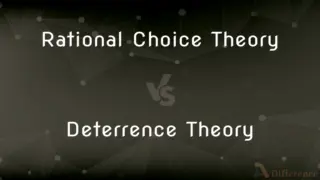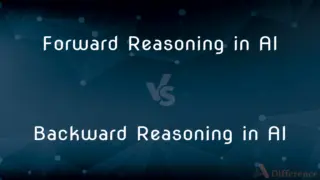Ethanol vs. Methoxymethane — What's the Difference?
By Tayyaba Rehman — Published on January 6, 2024
Ethanol is an alcohol with the chemical formula C2H5OH, commonly used as a solvent, in beverages, and as fuel. Methoxymethane, also known as dimethyl ether (DME), is an ether with the formula CH3OCH3, used as a propellant and refrigerant.

Difference Between Ethanol and Methoxymethane
Table of Contents
ADVERTISEMENT
Key Differences
Ethanol, also known as ethyl alcohol, is a two-carbon alcohol and is one of the most commonly used alcohols. It is known for its role in alcoholic beverages and as a biofuel. Methoxymethane (dimethyl ether), on the other hand, is an ether compound, consisting of two methyl groups connected by an oxygen atom. It finds use in industrial applications and as an aerosol spray propellant.
The physical properties of Ethanol include being a clear, colorless liquid with a characteristic odor and is miscible with water. Methoxymethane is a colorless gas under ambient conditions and is known for its low boiling point and high flammability.
In terms of chemical structure, Ethanol contains a hydroxyl group (-OH) attached to a carbon chain, which classifies it as an alcohol. Methoxymethane lacks this hydroxyl group and instead has an ether linkage (C-O-C), making it an ether.
Ethanol is widely used in the pharmaceutical, medical, and food industries, apart from its use as a recreational beverage and fuel. Methoxymethane is primarily used in the manufacture of other chemicals, as a solvent, and increasingly as an eco-friendly alternative fuel.
The production of Ethanol commonly involves the fermentation of sugars by yeast or the hydration of ethylene. Methoxymethane is typically produced from methanol through dehydration or from natural gas.
ADVERTISEMENT
Comparison Chart
Chemical Formula
C2H5OH
CH3OCH3
Type of Compound
Alcohol
Ether
Physical State
Colorless liquid
Colorless gas
Uses
Beverages, solvent, fuel
Propellant, refrigerant, industrial solvent
Chemical Structure
Contains a hydroxyl group (-OH)
Ether linkage (C-O-C), no hydroxyl group
Compare with Definitions
Ethanol
Colorless, volatile liquid used in many industries.
Ethanol is used as a solvent in the pharmaceutical industry.
Methoxymethane
Also known as dimethyl ether, used as a propellant.
Methoxymethane is commonly found in aerosol spray products.
Ethanol
Miscible with water and organic solvents.
Ethanol is used to extract essential oils due to its miscibility.
Methoxymethane
A colorless ether used in industrial applications.
Methoxymethane serves as a solvent in chemical syntheses.
Ethanol
A commonly used alcohol in beverages and as biofuel.
Ethanol is the active ingredient in alcoholic drinks.
Methoxymethane
Used as an eco-friendly refrigerant.
Methoxymethane is gaining popularity as a green refrigerant option.
Ethanol
Produced by fermenting sugars.
Yeast ferments sugar into ethanol in the brewing process.
Methoxymethane
Can be produced from natural gas.
Methoxymethane is generated as an alternative fuel from natural gas.
Ethanol
Used as an antiseptic and disinfectant.
Ethanol is a key component in hand sanitizers.
Methoxymethane
Known for its high flammability.
Due to its flammability, methoxymethane is handled carefully in industries.
Ethanol
(organic compound) A simple aliphatic alcohol formally derived from ethane by replacing one hydrogen atom with a hydroxyl group: CH3-CH2-OH.
Methoxymethane
Dimethyl ether
Ethanol
Specifically, this alcohol as a fuel.
Ethanol
The organic compound C2H5.OH, the common alcohol which is the intoxicating agent in beer, wine, and other fermented and distilled liquors; called also ethyl alcohol. It is used pure or denatured as a solvent or in medicines and colognes and cleaning solutions, or mixed in gasoline as a fuel for automobiles, and as a rocket fuel (as in the V-2 rocket).
Ethanol
The intoxicating agent in fermented and distilled liquors; used pure or denatured as a solvent or in medicines and colognes and cleaning solutions and rocket fuel; proposed as a renewable clean-burning additive to gasoline
Common Curiosities
Is Ethanol safe to consume?
Yes, in beverages, but industrial ethanol contains additives making it unsafe to drink.
Is Methoxymethane a gas or a liquid?
It's a colorless gas under ambient conditions.
What is Ethanol commonly used for?
As a beverage component, solvent, and fuel.
How is Ethanol produced?
Mainly through the fermentation of sugars by yeast or synthetic processes.
What are the environmental impacts of Methoxymethane?
It's considered an eco-friendly alternative with lower emissions.
What is Methoxymethane?
An ether compound, also known as dimethyl ether, used as a propellant and solvent.
Can Ethanol be used in medical applications?
Yes, as an antiseptic and in sterilization processes.
Where is Methoxymethane commonly found?
In aerosol sprays, industrial solvents, and as an alternative fuel.
Can Ethanol be used as a disinfectant?
Yes, it's effective as a disinfectant and antiseptic.
Is Methoxymethane used in refrigeration?
Yes, as an eco-friendly refrigerant.
Can Ethanol be used in all types of vehicles?
Only in engines designed for ethanol or flex-fuel vehicles.
What safety precautions are needed for Methoxymethane?
Proper handling and storage due to its high flammability.
What's the difference in chemical structure between Ethanol and Methoxymethane?
Ethanol has a hydroxyl group, while Methoxymethane contains an ether linkage.
Is Ethanol renewable?
Yes, when produced through fermentation of plant materials.
How does Methoxymethane compare to traditional fuels?
It's cleaner-burning with lower emissions.
Share Your Discovery

Previous Comparison
Rational Choice Theory vs. Deterrence Theory
Next Comparison
Forward Reasoning in AI vs. Backward Reasoning in AIAuthor Spotlight
Written by
Tayyaba RehmanTayyaba Rehman is a distinguished writer, currently serving as a primary contributor to askdifference.com. As a researcher in semantics and etymology, Tayyaba's passion for the complexity of languages and their distinctions has found a perfect home on the platform. Tayyaba delves into the intricacies of language, distinguishing between commonly confused words and phrases, thereby providing clarity for readers worldwide.












































